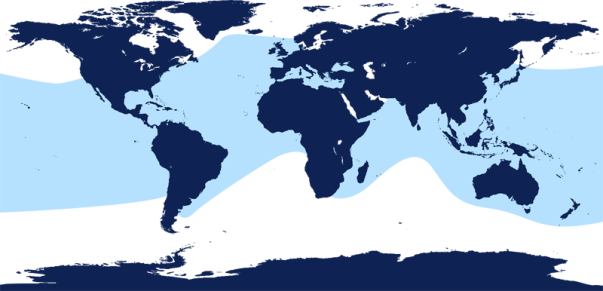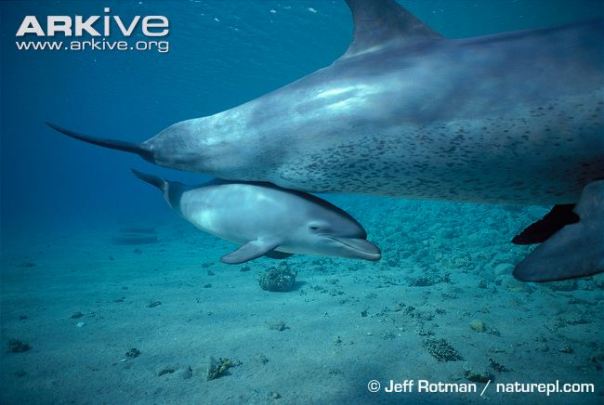- Name: Common bottlenose dolphin
- Latin: Tursiops truncatus
- Classification: Mammal
- Origin: Temperate and tropical waters
- Lifespan: 40-50 years
Taxonomy
- Kingdom: Animalia (Animals)
- Phylum: Chordata (Vertebrates)
- Class: Mammalia (Mammals)
- Order: Cetacea (Cetaceans)
- Family: Delphinidae (Oceanic Dolphins)
- Genus: Tursiops (Bottlenose Dolphins)
- Species: Tursiops truncatus (Common Bottlenose Dolphin)
Apperance
- Length: 2-3.9m (6.6-12.8ft)
- Weight: 150-200kg (331.5-442lbs)
The common bottlenose dolphin has a sleek, streamlined body with smooth skin which feels rubbery to the touch. The skin is hairless and has no sweat glands. The dolphins skin in 10-20 times thicker than that of terrestrial mammals and its cell turnover rate is nine times faster than a human (the outermost layer may be replaced every two hours), this is to ensure a smooth body surface. The skin colour is light-dark grey with white undersides.
The dolphin has pectoral (located on either side of the body), fluke (located at the end of the tail) and dorsal (located on the back) fins used for locomotion through the water. It has a rounded head (aka melon) with a long hard beak filled with conical, interlocking teeth. The animal is topped with a blowhole which is used for breathing, which is closed when relaxed and opens when muscles contract.
Relatives
- White beaked dolphin (Lagenomychus albirostris) -LEAST CONCERN-
- Harbour porpoise (Phocoena phocoena) -LEAST CONCERN-
- Baiji (Lipotes vexillifer) -CRTICIALLY ENDANGERED-
- Dusky dolphin (Lagenorhynchus obscurus) -DATA DEFICIENT-
Habitat & Distribution
Bottlenose dolphins can be found living in temperate and tropical waters worldwide, keeping to temperatures of between 10-32’C (50-90’F). They have been found to be living in coastal waters and the open ocean.
In the Pacific Ocean they are found from Northern Japan to Australia and from Southern California to Chile. While in the Atlantic, populations of this dolphin live from Nova Scotia to Patagonia and from Norway to South Africa. They can also be found in the Mediterranean and Black seas.

Diet
The diet of the bottlenose dolphin mainly consists of bottom-dwelling fish but will also eat squid, shrimps and cephalopods.
Their hunting methods vary, as they will hunt either alone or in groups. Echolocation is used to detect prey. The dolphin can produce up to 1,000 clicking sounds in a second. These sounds waves hit objects and bounce back to the dolphin, telling it about its location, size and shape. Dolphins will also follow fishing boats and eat any leftover fish thrown overboard. The bottlenose dolphin has also been observed to follow sting rays, which by using electroreceptors on the undersides of their bodies, are able to locate squid and octopuses hiding in sea grass.
In Brazil, these dolphins have been observed hunting co-operatively with people. They will drive fish into the nets of the local fisherman, who then give a share to the dolphins. Dolphins living in shallow water have been observed to hunt by swimming in tight circles around a shoal of fish and beating their tail hard, stirring up the silt behind them. This circle of mushrooming silt acts as a net, trapping the fish. In a blind panic the fish jump to escape, right into the mouths of the dolphins.
Behaviour
Bottlenose dolphins are very social animals and will live in groups of a few individuals up to 100. They can also be found living in three distinct groups, nursery groups, juvenile groups and adult male groups. Members of pods will often form a hierarchy based on the age, size and gender of the individuals. Large adult males will always dominate a group; however, in the absence of males, the largest female will take charge of the pod.
These dolphins have also proven themselves to be incredibly intelligent in their ability to solve complex problems and with the speed and effectiveness by which they can perfect behaviours. They also have the capacity to rest one half of their brain at a time, allowing them to remain conscious enough to keep surfacing for air.
Bottlenose dolphins have also been known to display epimeletic behaviour, meaning they will care for another individual during time of need. They will protect injured members of their pod and help them to the surface for regular breathes. This behaviour is most commonly observed in mothers whose calves have died.
Reproduction
Bottlenose dolphins are polygamous and will engage in mating behaviour in one of two ways. Males can look for females that are oestrous and will then separate her from her home range for a chance to mate with her. The male will also flank her to restrict access by other males and ensure a higher possibility that her calf will be his. Males may take on this form of searching for a mate, as waiting for a female to become sexually receptive can take several weeks.
Alternatively, males will wait for an oestrus female to enter his home range. He will then preform courtship by arching his back, stroking and nuzzling the female, clapping his jaws and yelping. Copulation will then occur belly to belly.
Females reach sexual maturity between 5-10 years of age, males at 8-13. The reproductive seasons of bottlenose dolphins vary from region to region. The females will ovulate at certain times of the year while the males will remain sexually active throughout the year (with a testosterone peak when females ovulate).
Gestation will last for about 12 months with each pregnancy producing only a single calf. The calves are nursed on their mother’s milk and are weaned at 18-20 months of age. A female dolphin will reproduce every 3-6 years and calves can be born at any time of the year, although there is a peak in birth rates during the warmer months. Female dolphins can also reproduce well into their forties.

Adaptations
- A bottlenose dolphin has thick skin which stops its blubber flapping in the water and reduces drag.
- The bottlenose dolphin has a fusiform shape, meaning it is one smooth shape. This allows for a streamlined body and thus faster movement in the water.
- The dolphin has very efficient lungs and can exchange 80% of its air in each breath, whereas a human can only exchange 17% at a time. The bottlenose dolphin can hold its breath for up to 12 minutes at a time.
- The bottlenose dolphin has a higher metabolic rate than land mammals of a similar size. This increased metabolism is used as a form of thermoregulation and allows it to maintain a body temperature of 36-37’C (96.8-98.6’F), about the same as a human.
Threats
Bottlenose dolphins have several threats including human disturbance, entanglement in fishing nets, hunting, disease and predators. They are also directly harvested in Japan and Taiwan for use in aquariums and shows and many others are slaughtered for their meat, leather and oil.
They are also susceptible to many kinds of disease and illnesses including viral, bacterial and fungal infections, stomach ulcers, urogenital and respiratory disorders, heart and skin disease and parasites (tapeworm, fluke and roundworm).
Their predators include large shark species such as tiger, dusky and bull sharks. They are also very rarely predated upon by killer whales. These dolphins are also vulnerable to chemical and noise pollution, heavy boat traffic, habitat destruction and competition with fisheries.
Conservation
IUCN Status: Least Concern
Common bottlenose dolphins are listed under Appendix II of CITES (which prohibits all commercial trade) and Annex II and IV of the EC Habitats Directive. All cetaceans are listed on Annex A of the EU Council Regulation 3 38/97, in addition all UK cetaceans are fully protected by the Wildlife and Countryside Act 1981 and the Wildlife (Northern Ireland) Order 1985.
All populations of bottlenose dolphins in the North and Baltic Sea, western Mediterranean and Black Sea are protected under Appendix II of the Convention of Migratory Species and Appendix II of the Bern Convention.
Fun Facts
- Male: Bull
- Female: Cow
- Young: Calf
- Group: Pod
- Bottlenose dolphins can breech as high as 4.9m (16ft).
- These animals can swim at speeds of up to 5-11kph (3-7mph).
- One dive can last 8-10 minutes.
- An adult eats about 4-5% of its body weight a day.
References
Bottlenose Dolphin [Online] Available at: http://en.wikipedia.org/wiki/Bottlenose_dolphin [Accessed: 7 October 2013]
Bottlenose Dolphin: Habitat & Distribution [Online] Available at: http://www.seaworld.org/animal-info/info-books/bottlenose/habitat-&-distribution.htm [Accessed: 18 October 2013]
Bottlenose Dolphins: Adaptations for an Aquatic Environment [Online] Available at: http://www.seaworld.org/animal-info/info-books/bottlenose/adaptations.htm [Accessed: 20 October 2013]
Bottlenose Dolphins: Physical Characteristics [Online] Available at: http://www.seaworld.org/animal-info/info-books/bottlenose/physical-characteristics.htm [Accessed: 7 October 2013]
Bottlenose Dolphin: Tursiops truncatus [Online] Available at: http://animals.nationalgeographic.co.uk/animals/mammals/bottlenose-dolphin/ [Accessed: 19 October 2013]
Bottlenose Dolphin (Tursiops truncatus) [Online] Available at: http://www.arkive.org/bottlenose-dolphin/tursiops-truncatus/ [Accessed: 19 October 2013]
Bottlenose Dolphin (Tursiops truncatus) [Online] Available at: http://www.nmfs.noaa.gov/pr/species/mammals/cetaceans/bottlenosedolphin.htm [Accessed: 20 October 2013]
Common Bottlenose Dolphin [Online] Available at: http://www.bbc.co.uk/nature/life/Common_Bottlenose_Dolphin [Accessed: 7 October 2013]
Dolphin Species [Online] Available at: http://everythingdolphins.com/dolphin-species.html [Accessed: 7 October 2013]
Longevity and Causes of Death [Online] Available at: http://www.seaworld.org/infobooks/Bottlenose/deathdol.html [Accessed: 20 October 2013]
Tursiops truncatus: Bottlenose Dolphin [Online] Available at: http://animaldiversity.ummz.umich.edu/accounts/Tursiops_truncatus/ [Accessed: 19 October 2013]
